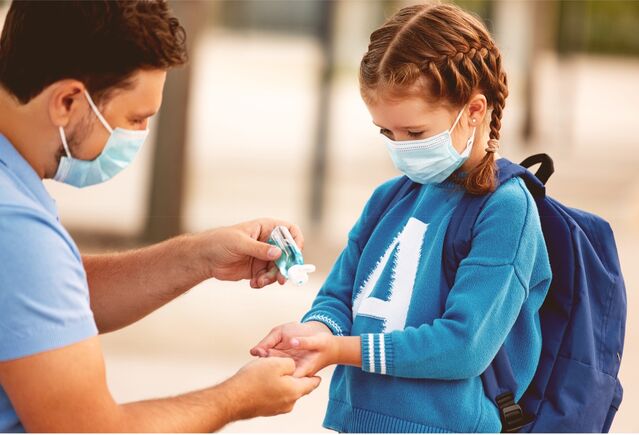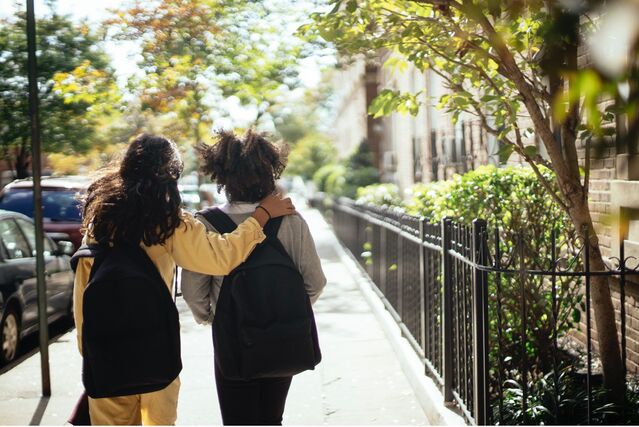Anxiety
The Return to School: Tips for Parents of Anxious Children
Strategies to support your child in the transition back to in-person learning.
Posted June 29, 2021 Reviewed by Devon Frye
Key points
- While many children and adolescents have suffered in the context of full and partial school closures, some may prefer learning from home.
- Children and adolescents who experience school anxiety may feel particularly apprehensive about the return to traditional, in-person learning.
- Parents can support their children by balancing empathy with their fears with clear expectations around school attendance.
This post was written by Dr. Allison Winik, an affiliate member of the Medical and Addictions working group of the COVID-19 Psychology Task Force (est. by 14 divisions of the American Psychological Association), which sponsors this blog.
My patient logged onto our Zoom session with an uncharacteristic grin. It was the last day of school and her year had been far from easy. Like many teenagers with anxiety, my patient struggled to manage the instability of hybrid learning. As the school year progressed, her anticipatory anxiety about the two days per week spent in school became so intolerable that she refused to attend in person at all. She began our session that day with a warning: “Just so you know, there is NO way that I’m going in person next year.”
There have been catastrophic disruptions to schooling during the COVID-19 pandemic. During the early stages of the pandemic, school closures impacted more than 1.6 billion children and adolescents worldwide. Over one year later, many school systems have resumed traditional, in-person learning; nevertheless, over 695 million children and adolescents continue to face full or partial school closures. In the United States, a survey of 4,300 public schools across the nation revealed that one year into the pandemic, 55 percent of elementary and 65 percent of middle school students continued to enroll in non-traditional learning models. However, with increasing vaccination rates and steadily declining case counts, non-traditional learners will not be the majority for long.
As the rate of infection continues to decline across the United States, families are looking to the fall with hope and optimism regarding a return to traditional learning. However, many students—particularly those prone to anxiety—may experience ambivalence regarding this change. Although early research shows that disruptions in schooling led to social isolation, worsened mood (Margolius, Lynch, Jones, & Hynes, 2020), increased anxiety (Rogers, Ha, & Ockey, 2020), and learning loss (Dorn, Hancock, Sarakatsannis, & Viruleg, 2020), some may have experienced benefits.
For those children that struggle with anxiety in school, in particular, school closures provided a natural escape from having to face their fears. Many with performance anxiety found temporary relief in the transition to open note testing and pass-fail grading systems, and those with social anxiety seized the opportunity to turn off their cameras and retreat from the classroom. Similarly, children fearful of separating from their parents welcomed the chance to spend full days in the comfort of their homes.
For this population, school reentry may come with its challenges. The following are some tips for supporting your anxious child in their transition back to school this fall.

1. Balance empathy with firm expectations.
It can be tempting to allow children to avoid the situations that make them anxious. Avoidance can often lead to an immediate reduction in stress; however, it results in detrimental long-term outcomes. When children avoid the triggers that make them anxious, they miss the opportunity to learn that they likely overestimated risk and underestimated their ability to cope with the situation. Over time, this avoidance can result in increased anxiety and belief that the only way to experience relief is the continued evasion of facing their fears.
This fall, anxious children and teens may resist leaving home in the morning, attending specific classes, or taking tests. In response, it will be critical to both express empathy with their feelings and set clear expectations that they approach their fears. For example, if your child is resistant to separating in the morning, you might validate their difficulties (“I understand it is hard to go to school on your own now that you are used to being at home with me”) while maintaining firm expectations that they attend school (“and it is important that you are a part of your class today. I can’t wait to hear about your day when I see you later this evening.”)
2. Model effective coping with anxiety.
Children learn from their adult models. One of the best ways to support your child in managing back-to-school stress is to demonstrate effective ways of coping with your own anxiety. This might include focusing on the positive, tolerating uncertainty, accepting situations that are out of your control, problem-solving, and practicing good self-care (e.g., maintaining an exercise routine).
3. Communicate about COVID-19 risk and safety protocols.
It is understandable for children and teens to feel anxious about in-person learning amid a pandemic. Address fears about getting sick by highlighting the different steps the school system is taking to ensure students’ safety and sharing encouraging data on the risk of transmission when these safety protocols are enforced. If you are unsure about the specific safety measures that the school is implementing, reach out to your child’s teachers to obtain more detailed information.

4. Practice approaching anxiety-provoking situations.
Exposure to feared situations is a core component of anxiety treatment. Through consistent exposure, clients tend to learn that they can tolerate the situations better than anticipated. In preparation for your child’s return to school, expose them to the different situations that make them nervous. Set up virtual or in-person activities with their peers, practice driving to school and separating at the entrance, set up meetings with teachers, and request early access to the school to reorient your child to the building. If your child is resistant to participating in any of these activities, validate their anxiety while staying firm in your commitment to facilitating their readjustment to school.
5. Establish a consistent school routine.
Anxious children benefit from consistency and structure, especially during times of uncertainty. To support your child in feeling more secure and in control, implement a new daily routine in the weeks preceding the start of school. Gradually set bed and wake times at earlier hours and ensure that your child starts their day by eating breakfast and addressing personal hygiene. Set a screen curfew at the start of the year to provide structure and ensure that your child can get a good night’s rest.
Transitions often create anxiety, even when they represent positive change. Just as your child adapted to learning from home at the start of the pandemic, they will eventually adjust to returning to the classroom. With your warm and firm support, this, too, shall pass.
Allison Winik, Ph.D. is an Assistant Professor of Medical Psychology (in Psychiatry) at Columbia University Irving Medical Center and Psychologist at the Columbia University Clinic for Anxiety and Related Disorders-Westchester (CUCARD-W). She specializes in the treatment of child, adolescent, and young adult anxiety disorders.
References
Anxiety Canada. Accommodating Anxiety. https://www.anxietycanada.com/articles/accommodating-anxiety-2/
Dorn, E., Hancock, B., Sarakatsannis, J., & Viruleg, E. (2020, December 8). Covid-19 and
learning loss: Disparities grow and students need help. New York, NY: McKinsey. https://www.mckinsey.com/industries/public-and-social-sector/our-insights/covid-19-and-learning-loss-disparities-grow-and-students-need-help
Margolius, M., Doyle Lynch, A., Pufall Jones, E. & Hynes, M. (2020). The State of Young
People during COVID-19: Findings from a nationally representative survey of high school youth. Americas Promise Alliance. https://www.americaspromise.org/resource/state-young-people-during-covid-19
National Center for Immunization and Respiratory Diseases (NCIRD), Division of Viral
Diseases (2021, March 19). Science Brief: Transmission of SARS-CoV-2 in K-12 schools. CDC COVID-19 Science Briefs. Atlanta, GA: Centers for Disease Control and Prevention. https://www.cdc.gov/coronavirus/2019-ncov/science/science-briefs/transmission_k_12_schools.html
Rogers, A. A., Ha, T., & Ockey, S. (2021). Adolescents’ perceived socio-emotional impact of COVID-19 and implications for mental health: Results from a U.S.-based mixed-methods study. Journal of Adolescent Health, 68(1), 43–52.
Stanford University. Resources for Parents of Children with Anxiety Disorders.
http://med.stanford.edu/content/dam/sm/elspap/documents/WEBSITES.pdf
U.S. Department of Education, Institute of Education Sciences, National Center for Education Statistics (2021). Monthly School Survey Dashboard. https://ies.ed.gov/schoolsurvey/




